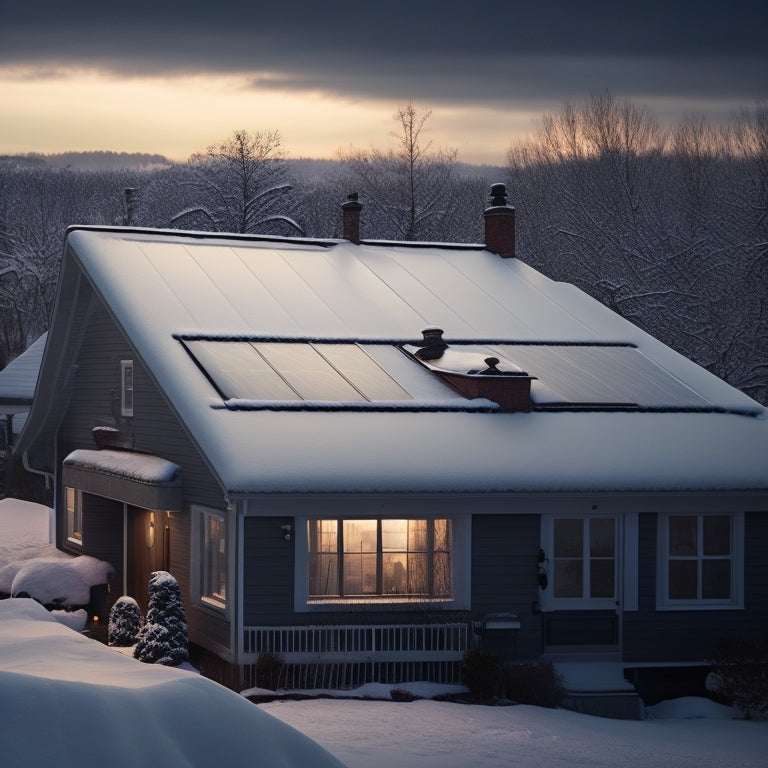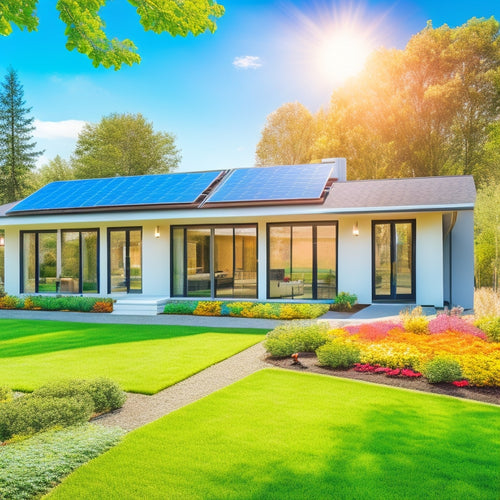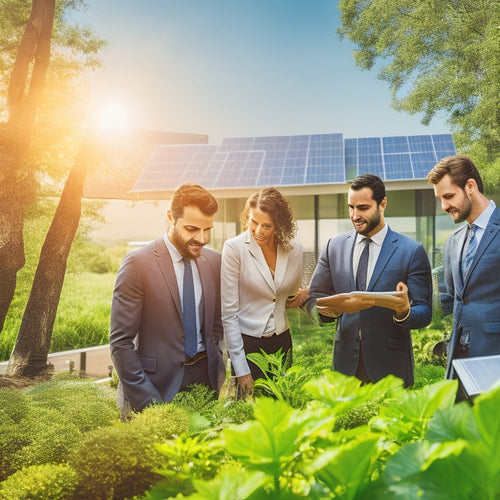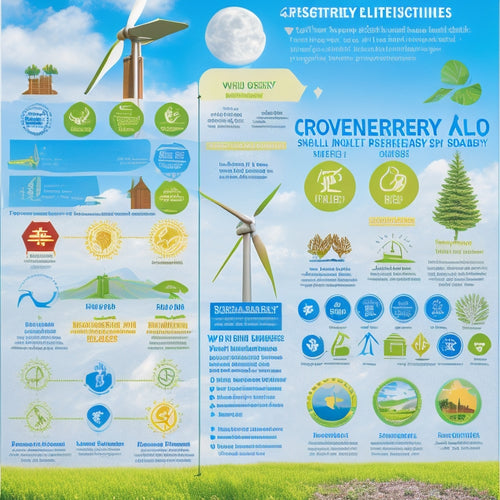
What Are the Cons of Installing Solar Panels on Your Roof
Share
As you evaluate installing solar panels on your roof, be aware that high upfront costs, ranging from $15,000 to $30,000 or more, can be a significant barrier. Additionally, your roof's orientation, shading, and size may limit the number of panels you can install, and energy storage challenges require a substantial investment in battery systems. Intermittent energy production means you'll still need the grid for stable energy supply. Aesthetics, regulatory concerns, and maintenance responsibilities also come into play. Moreover, technical and efficiency issues, like system compatibility and energy waste, can impact performance. It's vital to weigh these cons carefully to guarantee solar panels are right for you - and there's more to assess.
Key Takeaways
- High upfront costs of solar panel installation, ranging from $15,000 to $30,000 or more, can be a significant financial burden.
- Roof suitability limitations, including orientation, shading, and condition, can affect energy output and feasibility of installation.
- Energy storage challenges, including excess energy generation and high upfront costs of battery systems, can make nighttime use difficult.
- Intermittent energy production due to daylight and seasonal changes can lead to grid dependency and power outages without storage systems.
- Aesthetics and regulatory concerns, including visual impact and HOA regulations, can impact property value and installation feasibility.
High Upfront Installation Costs
The high upfront installation costs of solar panels are a significant drawback for many homeowners and businesses. You may be keen to utilize the power of renewable energy, but the initial investment can be intimidating. The cost of purchasing and installing solar panels can range from $15,000 to $30,000 or more, depending on the size of your system and the quality of the equipment.
However, you don't have to foot the entire bill upfront. You can investigate financing options, such as loans or power purchase agreements, to spread the cost over time.
Additionally, you can take advantage of tax incentives, like the federal solar investment tax credit, which allows you to claim a percentage of the total cost as a tax credit. This can help offset the initial expense and make solar energy more accessible.
Roof Size and Shape Limitations
Often, homeowners eager to switch to solar energy face a significant hurdle: the size and shape limitations of their roof. You may discover that your roof isn't suitable for solar panels due to its dimensions, orientation, or configuration. This can greatly affect the performance of your solar panel system.
Here are three important limitations to evaluate:
-
Roof orientation: If your roof doesn't face south, you may not receive the best amount of sunlight, reducing the energy generation capacity of your solar panels.
-
Shading issues: Trees, chimneys, or other obstructions can cast shadows on your roof, diminishing the energy output of your solar panels.
-
Insufficient roof space: If your roof is too small, you may not be able to install enough solar panels to generate the energy you need.
These limitations can result in reduced energy production, making it vital to assess your roof's suitability for solar panels before installation.
It's essential to consult with a solar panel professional to determine the most effective approach for your specific situation.
Energy Storage Challenges
With solar panels generating electricity during the day, you're left wondering what happens to the excess energy when the sun goes down or during periods of low energy usage. This is where energy storage comes in, but it poses its own set of challenges.
You'll need to invest in a battery system that can store the excess energy generated during the day for use at night or during power outages. However, selecting the right energy storage system can be tricky.
You'll need to take into account factors such as energy capacity, system compatibility, and cost. A system with insufficient energy capacity may not meet your power needs, while one that's too large may be a waste of resources.
Furthermore, ensuring system compatibility with your existing electrical infrastructure is essential to avoid technical issues. Additionally, the high upfront cost of energy storage systems can be a significant barrier for many homeowners.
Intermittent Energy Source
One major drawback of solar panels is their reliance on an intermittent energy source. You may have experienced days with minimal sunlight or seasons with shorter days, which greatly impact your energy production. This variability in energy production means you can't always depend on solar panels to meet your energy needs.
Here are three key implications of this intermittency:
-
Energy production variability: Solar panels generate energy only when the sun is shining, which means your energy production will fluctuate daily and seasonally.
-
Grid dependency: To maintain a stable energy supply, you may need to remain connected to the grid, which can offset some of the environmental benefits of solar energy.
-
Unpredictable energy supply: Without a reliable energy storage system, you may experience power outages or reduced energy availability during periods of low sunlight.
These limitations highlight the importance of carefully evaluating your energy needs and determining the feasibility of solar panels for your specific situation.
Aesthetics and Neighborhood Covenants
Solar panels' visual impact can be a significant concern for homeowners, particularly those living in neighborhoods with strict aesthetic standards. You may worry that the panels will clash with your home's design preferences or detract from its curb appeal.
Additionally, you may be concerned about how the panels will affect neighborhood aesthetics, potentially impacting property values.
Homeowner associations (HOAs) often have rules governing exterior modifications, including solar panel installations. Before installing solar panels, you'll need to check with your HOA to verify compliance with their regulations.
Some HOAs may have specific requirements for panel color, size, or placement, while others may prohibit solar panels altogether.
It's essential to weigh the potential impact of solar panels on your property's appearance and value. While solar panels can increase your property's appeal to environmentally conscious buyers, they may not appeal to everyone.
Consider consulting with a solar panel professional to determine the most aesthetically pleasing installation options for your home.
Maintenance and Repair Concerns
When you install solar panels, you'll need to contemplate the maintenance and repair concerns that come with them.
You'll be responsible for ensuring your panels remain in good condition, which can be a challenge, especially since they're exposed to the elements.
You'll need to be prepared to address potential issues like panel damage, cleaning requirements, and technical glitches.
Panel Damage Risk
Behind the sleek, modern exterior of solar panels lies a complex system of photovoltaic cells, wires, and inverters, which can be damaged by various environmental and physical factors.
As a homeowner contemplating solar panels, you should be aware of these potential risks to guarantee you're prepared for any maintenance or repair needs that may arise.
Here are three common risks to your solar panel system:
-
Weather-related damage: Hail, heavy snowfall, and strong winds can cause physical damage to your solar panels, reducing their efficiency or rendering them inoperable.
-
Electrical surges: Power surges or electrical storms can damage your inverters or other electrical components, leading to costly repairs or even system failure.
-
Physical obstructions: Debris, such as leaves or branches, can block sunlight and reduce your solar panel's energy output. Additionally, physical damage from animals or accidental damage during roofing work can also impact your panel's performance.
It's crucial to evaluate these risks and plan accordingly to maintain your solar panel system's peak performance and extend its lifespan.
Confirm you obtain the necessary installation permits and follow the manufacturer's guidelines for maintenance and repair to minimize downtime and maximize your energy output.
Regular Cleaning Needed
Dust, dirt, and debris accumulate on your solar panels over time, gradually reducing their energy output. This debris accumulation can lead to a significant decrease in your system's efficiency, which can be frustrating if you're relying on them for power.
To maintain peak performance, you'll need to clean your solar panels regularly. The cleaning frequency will depend on various factors, including your location, climate, and the type of panels you have installed. If you live in an area with high levels of air pollution, dust storms, or heavy tree cover, you may need to clean your panels more frequently.
On average, cleaning every 6-12 months is recommended. Failure to do so can result in energy losses of up to 25% or more.
It's vital to note that improper cleaning methods can damage your solar panels. Avoid using harsh chemicals, abrasive materials, or high-pressure washes, as these can scratch or damage the panels' surface.
Instead, use a soft brush, mild soap, and distilled water to guarantee a safe and effective cleaning process.
Technical Glitches Possible
Operating solar panels requires monitoring and addressing technical issues that can arise, affecting their performance and efficiency. You'll need to keep an eye out for potential glitches that can reduce the amount of power your system produces.
Some technical issues you may encounter include:
-
System compatibility issues: If your solar panel system isn't compatible with your electrical setup, it can lead to reduced efficiency or even complete system failure.
-
Inverter malfunctions: Inverters convert DC power from your solar panels to AC power for your home. Malfunctions can cause your system to shut down or produce less power.
-
Faulty or damaged components: Defective or damaged components, such as faulty wiring or broken panels, can reduce your system's overall performance.
You'll need to address these technical issues promptly to guarantee your solar panel system operates at its best.
Regular maintenance and repair can help prevent these issues from arising in the first place. By being aware of these potential technical glitches, you can take steps to minimize their impact and keep your solar panel system running smoothly.
Inefficient Energy Conversion
When you install solar panels, you'll find that they don't convert sunlight into electricity as efficiently as you might expect.
The low energy output means you'll need more panels to meet your energy needs, which can increase installation costs.
Additionally, conversion rate issues and energy waste generation can further reduce the overall efficiency of your solar panel system.
Low Energy Output
Beyond the hype surrounding solar panels, it's vital to acknowledge that they often fall short regarding energy output. You might be expecting a significant reduction in your energy bills, but the reality is that solar panels don't always deliver as promised. This is due to their limited energy efficiency, which affects their overall performance.
Here are three key factors that contribute to low energy output:
-
Panel Efficiency: Solar panels have an average efficiency rate of 15-20%. This means that a significant amount of sunlight is wasted, failing to generate usable energy.
-
Shading and Orientation: If your roof receives partial shading or isn't ideally oriented towards the sun, energy output will suffer. Even slight obstructions can reduce energy production.
-
Temperature and Climate: High temperatures and extreme weather conditions can decrease solar panel efficiency, further reducing energy output.
Considering these limitations, it's important to carefully weigh the benefits of solar panels against their drawbacks.
While solar incentives can help offset the cost, you should be aware of the potential for low energy output and plan accordingly.
Conversion Rate Issues
Nearly 20% of the energy generated by solar panels is lost during the conversion process, highlighting a significant inefficiency in the system. This conversion rate issue means you're not getting the full benefit of your solar panel investment. While you'll still generate some electricity, the loss of energy translates to reduced power output and lower savings on your utility bills.
Unfortunately, this inefficiency is inherent to the technology, and even the most efficient solar panels on the market can't escape this limitation.
To make up for these losses, you might need to install more solar panels or invest in more efficient models, which can increase your upfront costs. However, government incentives and financing options can help offset these expenses.
Despite these drawbacks, solar panels remain a viable option for homeowners seeking to reduce their carbon footprint. By understanding the conversion rate issues, you can make informed decisions about your solar panel installation and find ways to maximize your energy output.
Energy Waste Generation
About 15% of the energy captured by solar panels is wasted as heat during the energy conversion process. This energy waste generation is a significant drawback of installing solar panels on your roof. You might be thinking that solar panels are environmentally friendly, but the inefficient energy conversion process reduces their overall energy efficiency.
Here are three key reasons why energy waste generation is a concern:
-
Heat dissipation: Solar panels convert sunlight into electrical energy, but they also generate heat as a byproduct. This heat can reduce the panel's efficiency and lifespan.
-
Inverter losses: The DC power generated by solar panels needs to be converted to AC power for your home. This conversion process, done by inverters, results in energy losses.
-
System inefficiencies: Other system components, such as wires and connectors, can also contribute to energy losses, reducing the overall energy efficiency of your solar panel system.
To mitigate this issue, it's crucial to focus on waste management and energy efficiency.
Look for solar panels with high efficiency ratings, and consider investing in energy-efficient inverters and system components. By doing so, you can minimize energy waste generation and maximize your solar panel system's performance.
Battery Replacement Expenses
Several solar panels systems rely on deep cycle batteries to store excess energy generated during the day for nighttime use or during power outages.
These batteries have a limited lifespan, typically ranging from 5 to 15 years, depending on the type and quality. As a homeowner, you'll need to factor in the cost of replacing these batteries periodically.
The battery lifespan will impact your replacement frequency. If you opt for a lower-cost battery with a shorter lifespan, you'll need to replace it more often, increasing your overall expenses.
On the other hand, investing in a high-quality battery with a longer lifespan may reduce your replacement frequency but comes with a higher upfront cost.
You should consider the total cost of ownership, including the initial installation and ongoing maintenance, as well as the replacement expenses.
On average, you can expect to pay between $5,000 and $15,000 or more for a battery replacement, depending on the system size and type.
It's important to weigh these costs against the benefits of having a solar panel system to determine if it's the right choice for your energy needs.
Frequently Asked Questions
Do Solar Panels Void My Roof's Warranty?
When you install solar panels, you'll need to check your roof's warranty terms, as some manufacturers may void it; however, many won't, and you'll still benefit from reduced installation costs and a sustainable energy source.
Can I Install Solar Panels on a Metal Roof?
You can install solar panels on a metal roof, but you'll face metal roof compatibility and installation challenges, requiring specialized mounting systems and careful planning to guarantee a secure, watertight seal.
Do Solar Panels Increase My Property Taxes?
You'll want to know that installing solar panels may increase your property taxes due to the increased value of your property, but the solar panel assessment often results in a minimal property tax implications, so it's worth exploring.
Can I Sell Excess Energy Back to the Grid?
As you capture the sun's power, you'll be thrilled to know you can sell excess energy back to the grid through net metering benefits and energy buyback programs, offsetting your utility bills and putting money back in your pocket.
Are Solar Panels Resistant to Hail and Extreme Weather?
You'll be glad to know that solar panels are designed to withstand harsh weather conditions, including hail damage; in fact, most panels are tested to resist hail up to 1 inch in diameter, ensuring your system's weather durability.
Conclusion
You've weighed the pros and cons of installing solar panels on your roof. While they can reduce your carbon footprint, there are significant drawbacks to take into account. Did you know that the average American uses 900 kilowatt-hours of electricity per month? With solar panels, you'd need a substantial roof space to generate that much power. Ultimately, it's crucial to carefully evaluate the cons, from high upfront costs to energy storage challenges, before making a decision that's right for your wallet and the environment.
Related Posts
-

How Solar Panels Increase Property Value
Installing solar panels considerably increases your property value by improving energy efficiency and attracting eco-...
-

Evaluating Solar Power Options for Businesses
Evaluating solar power options for your business can greatly reduce energy costs and enhance sustainability. Start by...
-

Renewable Energy Certifications for Businesses
Renewable energy certifications are essential for your business, showcasing your commitment to sustainability and enh...


